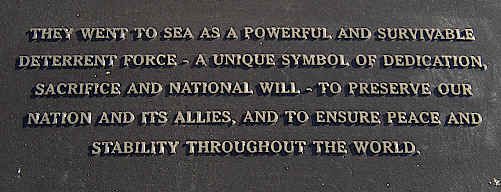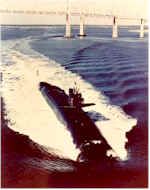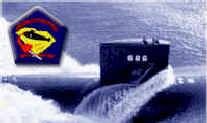

Through peace and war, the citizens of South Carolina and especially the greater Charleston area demonstrated a strong and unfailing commitment to the defense of our Nation through undaunted support of our military forces. This commitment often was not fully recognized by those beyond the Lowcountry.

At the peak of the Cold War, as many as 40,000 Submariners, their families, and civilian workers were part of the Lowcountry submarine community. In addition, there were also thousands of additional military members and families from all branches of the armed services who were members of this great community. For the Submarine Force, the Lowcountry was truly indispensable. For the initial twenty-five-plus years of the Cold War, virtually all of the strategic ballistic missiles that went to sea as part of our nation's sea-based nuclear deterrent force were assembled and loaded into our Fleet Ballistic Missile (FBM) submarines in Charleston. Each of the "Forty-one for Freedom" FBM submarines, including those of the Pacific Fleet, loaded their test missiles here; and all but two of these awesome warships loaded their war reserve missiles and sailed on their initial deterrent patrol from Charleston. Each carried 16 missiles with a combined destructive force greater than all the explosives used in World War II. Also, every British Royal Navy FBM submarine loaded their missiles in Charleston.

During the Cold War, more submarine crews deployed from Charleston, in or to their submarines, for strategic deterrent patrol than from any other United States port. Our nation's most survivable and effective strategic deterrent became a reality when USS George Washington (SSBN 598), the U.S. Navy's first FBM submarine, sailed on her first Cold War patrol on November 15, 1960 from Naval Weapons Station, Charleston.
 Throughout the years of the Cold War, the Charleston community and their leaders warmly welcomed and offered unsurpassed hospitality to our Submarine Force families and to those of all local military services. In addition and most importantly, the Charleston area offered members of the military and their families a cultural and economic environment which was seldom matched and largely unsurpassed by other communities where military families were based. The greater military community returned back to the Lowcountry equal to what they received through support of the United Way, Red Cross blood drives, school teacher, and student recognition programs, highway and beach cleanups, disaster relief efforts, manning the classrooms as teachers and volunteers, and many other projects. Submarine families actively sought assignment to Charleston. Many remained after leaving the Service and are active today as citizens, valued workers, respected as members of the community, and serving as elected and appointed officials.
Throughout the years of the Cold War, the Charleston community and their leaders warmly welcomed and offered unsurpassed hospitality to our Submarine Force families and to those of all local military services. In addition and most importantly, the Charleston area offered members of the military and their families a cultural and economic environment which was seldom matched and largely unsurpassed by other communities where military families were based. The greater military community returned back to the Lowcountry equal to what they received through support of the United Way, Red Cross blood drives, school teacher, and student recognition programs, highway and beach cleanups, disaster relief efforts, manning the classrooms as teachers and volunteers, and many other projects. Submarine families actively sought assignment to Charleston. Many remained after leaving the Service and are active today as citizens, valued workers, respected as members of the community, and serving as elected and appointed officials.
Today it is clearly evident that, without this truly superior and consistent support from the citizens of South Carolina and particularly from those of the greater Charleston community, those units of Submarine force which were based in and supported from Charleston during the Cold War would have been less motivated, less capable, and less effective. The sincere gratitude and warm feelings for the people of the Lowcountry will endure in the hearts of the men and families who manned our Cold War submarines from Charleston for many generations to come.